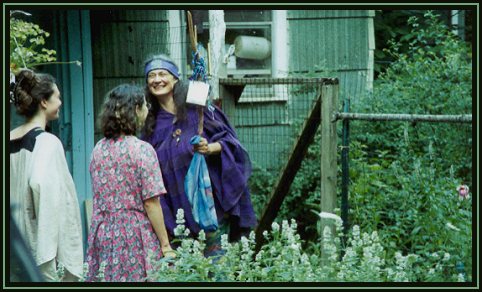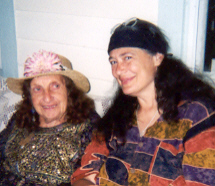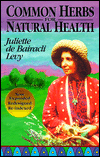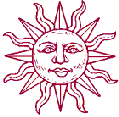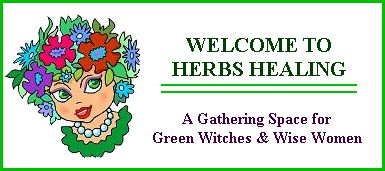The Story of the Moon Goddess
by Trudelle Thomas
Excerpt from: Moon
Days - Creative Writings About Menstruation
"The Story of the Moon Goddess," ends the third section
of the book, a culmination of celebrations of positive visions of menstruation
for girls and women. In this story, young Helena is visited by a Moon
Goddess who teaches her to love herself, not only at puberty but all
through her life. The Moon Goddess gives Helena a great gift-a Moontime
Journal-to record not only her fears but also her hopes and dreams.
The story ends as Helena passes the Moon Goddess' gifts to her daughter,
Nacole, as she leaves her own cycles behind.
Once upon a time, there lived a young girl named Helena. Twelve years
old, she was eager to become a woman. Her mother had told her about
the beautiful Moon Goddess who would visit Helena soon to awaken in
her the seeds of life. Her mother spoke of the first time the goddess
had visited her, clad in a white robe, and with a voice as tender and
caressing as the light of the moon. She gave Helena a small glow-in-the-dark
star to place in the window to let the Moon Goddess know she was welcome.
Helena was nervous! She put the star in the corner of her window. There
it remained, night after night. Months passed. Helena waited.
One night it finally happened. She awoke from a dream
and there, in front of her bedroom window, in a pool of moonlight stood
the Moon Goddess. She was even more beautiful than Helena expected:
tall, with a ruddy, freckled face, and wearing a gleaming white robe
that flowed from her shoulders, over her bosom and curving body, and
down her long, muscular legs. The robe reached nearly to the floor.
Her sweet voice filled the room. "My dear Helena,
the time has come for our meeting. Your body is ready. Since even before
your birth, seeds of life have been waiting. Tonight I come to awaken
them!"
Helena leaned against her pillow. She didn't know what to say yet she
felt great peace and happiness just in being in the presence of the
goddess.
The shining goddess continued to speak. "Beginning
now, the seeds of life will start to flow in your body. Each cycle of
the moon one seed will ripen and flow forth. The door to motherhood
has opened. Your body has the power to grow a new human being!"
"But I'm not ready to grow a human being!" Helena
felt a little terrified. She looked pale in the moonlight.
"My darling girl, don't worry. It's a very slow becoming, very
slow," said the goddess. "Let me explain. I know you've heard
about the biological part: the ovaries, and fallopian tubes, and the
uterus. I'm her to tell you about the most important part-the magic
of it.
"The seeds of motherhood are only one part of your
transformation. The same power that releases them will cause your body
to change: your breasts will grow, your hips will curve and your body
will begin to become a woman's body. You will hurt sometimes, but that's
part of the becoming.
"And your feelings will grow too! You will be able
to love other people in a way you never have before! Your understanding
of the world will deepen. Oh, Helena-this is the crossing over point
for you! Your power as a woman will be released."
"Gee willickers," said Helena. "I'm not
sure I'm ready."
"You are ready to start. Remember, the becoming is
slow." The Moon Goddess leaned down and placed a rose on Helena's
pillow. "I'll come again to help you. And don't forget," the
Goddess leaned down and whispered in Helena's ear-"boys never get
to meet me." With that she disappeared.
The next morning when Helena awoke, she found the mark
of blood, hidden in the folds of her clothes. She knew from her mother's
stories that this was a reminder of the visit of the Moon Goddess. Her
mother bought her a big bouquet of roses, and they celebrated with a
tea party, just the two of them.
Before many months had passed, Helena awoke again in the
night to find the Moon Goddess standing at the foot of her bed. As before,
she was tall and ruddy, and strong, and her gown shone in the moonlight.
"Helena, my darling, I've come to give the help I promised."
"Oh, dear Moon Goddess, I'm so happy to see you.
The changes you spoke of have begun." This time Helena was no longer
afraid. She felt happy and excited in the presence of the goddess.
"For the next forty years I will come to visit you. Sometimes you
will wake and see me. Other times only the mark of blood will let you
know I've been here. When you see the red stain, remember the roses
your mother gave you-plump roses, crimson and bursting with life-roses
to remind you of the power of life inside you."
"It's such a big change for me," said Helena.
"Please listen closely, my darling. When you see
my mark, it must be a reminder to you to cherish your body and your
soul. Every morning, when you wake up, before you dress, I want you
to stand naked before your mirror and thank your body for the power
of life it holds."
"That's so embarrassing!" giggled Helena.
"Stand alone in your room and look at each part,
one by one. Thank each part and rejoice in it. There may be seasons
in your life when others adore your body, and seasons when they make
fun of it. Through all the seasons, I want you to give thanks to this
dear body."
"But it's so funny looking! My legs are bony. My
breasts look like mosquito bites!" giggled Helena.
"That's all the more reason to thank it. Your body is yours-it's
been given to serve you and to give you pleasure. But it has a life
of its own-and it may never look the way you think it should. Give your
body the respect and love that you would give any cherished friend.
When you respect her, other people will too."
"I'll try," Helena whispered. Again, the Moon Goddess placed
a rose on Helena's pillow and disappeared.
In the mornings that followed, Helena stood naked before the mirror
and gave thanks to each part of her body-her nose and her ears and her
freckles, her elbows and her privates and her legs. At first, she was
a little embarrassed but as time passed she liked the feeling of pride
that she felt.
A few more months went by and again the Moon Goddess appeared
in Helena's bedroom. By now she felt so comfortable with the goddess
that she wasn't even surprised when she opened her eyes to her shining
white robes and smiling face. This time, the Moon Goddess sat on the
edge of Helena's bed as she talked.
"Since you've done such a good job of thanking your
body every day, my darling, I've come to give you some more advice.
Keep standing before the mirror every morning. Here's something else
that I'd like you to try.
"Remember: the mark of blood is a sign you must cherish
both your body and your soul. Each moon-cycle, I want you take some
time to hide away alone to a secret place. Find a place where you can
be alone to think your own thoughts and dream your own dreams. Maybe
it will be an attic corner or a branch in a tree or a hide-away near
a creek. Just so it's secret and beautiful and safe. Tell only your
mother. It will be your special holy place. Then, look for other times
to get away as well.
"I want you to protect your hide-way now as a maiden,
and even more when you are a grown woman. As you grow up, you'll understand
why. Then, I think you should go take yourself out to lunch regularly,
and maybe take some vacations all alone."
Now the Moon Goddess handed Helena a book, bound in fabric
printed with pink a red roses. When Helena opened it, she saw that its
pages were blank. The Goddess spoke again, "This is your Moontime
Journal. Write about your hopes and dreams in it. Write down any night
time dreams you have, too. It will help you to be true to your best
self. And here are some more ideas: some of my girls save their moontime
blood in a stone chalice. Others take the blood and pour it on their
plants to help them grow. Think about it. It's precious." With
that, the goddess vanished.
Years passed, and every month the Moon Goddess visited
Helena, leaving her red mark. Sometimes she caught a glimpse of the
goddess, but more often she didn't.
Often on a clear night, Helena gazed at the moon overhead
and prayed silently her thanks for the changes in her life.
As she got to know the goddess, Helena learned that she
had many moods. She could be unpredictable, sometimes slipping in early
and unannounced. Other times she held off her visit days or even weeks,
leaving Helena to wonder where she might be. Sometimes her visits were
quiet, other times stormy and overwhelming. Sometimes Helena hurt so
much that she wanted to holler at the goddess. Still, when she remembered
to cherish her body and soul, the visits left a sweet memory.
In time, Helena found a mate and gave birth to her first
child-a daughter she named Nacole. More children followed, and with
each one Helena rejoiced in the power of her body to grow and change
and produce new life. She rejoiced, too, in the power of her mind and
heart to grow as her life changed.
She still wrote in her Moontime Journal. One time she
made a list of some of the gifts the goddess had given her:
I am proud of my body, she wrote.
Nobody takes me for granted.
I know I have an important life to live.
I speak my mind.
Next year I will run in a marathon.
I never drink Slim-fast.
I buy myself silk underwear sometimes.
I take baths by candlelight while my husband watches the kids.
I never wear shoes that pinch.
I love all the roses she's left, and my plants are thriving.
The Moon Goddess continued her visits each moon cycle.
Only when Helena carried a child in her womb or at her breast did the
goddess fail to leave her mark of blood. Perhaps she knew that the child
herself was proof enough of her presence. Helena rejoiced in the milk
that flowed through her breasts-visible proof of the power of life in
her.
More years passed and young Nacole was ready to meet the
Moon Goddess. Like her mother before her, Helena gave Nacole her little
glow-in-the-dark star and told her about the tall and beautiful goddess
with the gleaming white robe and the voice like music. One night when
Nacole was twelve, the Moon Goddess appeared in Helena's room. She was
as beautiful as ever. "Helena, I have some more advice to you.
Now that Nacole is a maiden, promise me that you will pass on to her
your pride in womanhood. Let her find delight in her body, never shame.
Help her cherish her life. Help her eat healthy foods and maybe run
track and speak up at school and everywhere. Celebrate her intelligence
and her talents.
"Let your daughter know that she has unique gifts
for the world-ones that no one else can give. Can you promise me this?"
"How could you ever doubt me?" said Helena.
"I've already bought her a Moontime Journal. We've made a womb-sculpture
for our garden!"
"Well, here's a gift for you, my love." The
Moon Goddess handed Helena a pearl necklace that shone white in the
moonlight.
The next month, the Moon Goddess visited young Nacole.
Like her mother before her, Helena celebrated the happy crossing over
with a bunch of roses and a tea party. In the years that followed, mother
and daughter often gave each other roses as a joyful reminder of the
power they shared.
In time, the Moon Goddess's visits to Helena grew rare.
She sensed that she was about to enter a new stage of her life, and
she remembered again the excitement of being twelve years old and full
of questions. One night the Moon Goddess appeared again, filling her
bedroom with moonlight and her musical voice.
"My beloved Helena, after tonight, my visits will dwindle. It has
been forty years. Together we have been through so much-we have become
deep friends. I am proud of the life that has flowed from you. Now you
are ready for the next level. Soon my dear sister, the Wisdom Goddess,
will visit. Because you have become a wise woman, you will need no mark
to know her presence. She will come again and again for the rest of
your life, and through all that time life and wisdom will flow through
you.
And so it happened that both Helena and her daughter Nacole
lived to be beautiful, spirited, and happy old women. The goddesses
stayed true to their promises, filling their households with peace and
pleasure. Even in times of disappointment or sorrow-for they still had
sorrows-both mother and daughter knew that the goddesses would return
and heal all hurts.
When Helena passed out of the earthly world, full of wisdom
and years, Nacole and her own daughter planted a rosebush on the grave.
The end
and the beginning.
Story of the Moon Goddess, by Trudell Thomas, is part
of a collection of short stories on menstruation from Moon Days,
Creative Writings About Menstruation, edited by Cassie Preemo
Steele. This story was written in honor of her twelve-year-old niece,
Caitlin Helena Thomas.

Editor: Cassie Premo Steele, Ph.D. A literary, passionate,
and profound collection. Twenty-six writers explore the "silent"
parts of women's lives; reawakening our memories of embarrassment and
shame and transforming them to wonder, excitement, and laughter.
176 pages, illustrations.
Retails for $13.95 Order at: www.wisewomanbookshop.com
Read
a review of Moon Days
Find out about moonlodges
held at the Wise Woman Center






